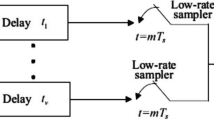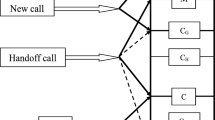Abstract
In Cognitive Radio Network, after sensing process, the selection and decision for a reliable channel from the list of free channels is important for assignment to Cognitive Users (CUs) for communication with Quality of Service (QoS). In this paper a consistent spectrum selection and decision scheme with two-fold neural network has been proposed for selection and decision process and its performance is compared with the schemes of Genetic algorithm and Back Propagation Neural Network (BPNN). BPNN- Adaptive Neuro Fuzzy Inference System (ANFIS) is a two-fold spectrum selection and decision approach which combines both BPNN and ANFIS techniques. A channel with the required QoS is selected based on the parameters such as Primary User (PU) states, signal strength, spectrum demand, velocity and distance. The simulation analysis shows that the BPNN–ANFIS technique reduces probability of blocking and dropping and therefore the accuracy of reliable channel selection obtained for the CUs use is more than 92%. The blocking probability of the proposed technique ranges from 1 to 3% which is much lower than the Genetic Algorithm (9–50%) and BPNN (8–40%). The maximum dropping probability of the proposed technique is only 4% and this is lower compared to 20% dropping in the other two techniques.




















Similar content being viewed by others
References
Ahmadfard, A., Jamshidi, A., & Keshavarz-Haddad, A. (2017). Probabilistic spectrum sensing data falsification attack in cognitive radio networks. Signal Processing, 137, 1–9.
Bradonjić, M., & Lazos, L. (2012). Graph-based criteria for spectrum-aware clustering in cognitive radio networks. Ad Hoc Networks, 10(1), 75–94.
Tahir, M., Habaebi, M. H., & Islam, M. R. (2017). Novel distributed algorithm for coalition formation for enhanced spectrum sensing in cognitive radio networks. AEU-International Journal of Electronics and Communications, 77, 139–148.
Kieu-Xuan, T., & Koo, I. (2013). A cooperative spectrum sensing scheme using adaptive fuzzy system for cognitive radio networks. Information Sciences, 220, 102–109.
Kapoor, G., & Rajawat, K. (2015). Outlier-aware cooperative spectrum sensing in cognitive radio networks. Physical Communication, 17, 118–127.
Haghighat, M., & Sadough, S. M. S. (2014). Cooperative spectrum sensing for cognitive radio networks in the presence of smart malicious users. AEU-International Journal of Electronics and Communications, 68(6), 520–527.
Paul, A., & Maity, S. P. (2016). Kernel fuzzy c-means clustering on energy detection based cooperative spectrum sensing. Digital Communications and Networks, 2(4), 196–205.
So, J., & Kwon, T. (2016). Limited reporting-based cooperative spectrum sensing for multiband cognitive radio networks. AEU-International Journal of Electronics and Communications, 70(4), 386–397.
Maity, S. P., Chatterjee, S., & Acharya, T. (2016). On optimal fuzzy c-means clustering for energy efficient cooperative spectrum sensing in cognitive radio networks. Digital Signal Processing, 49, 104–115.
Jiao, C. H., Wang, K. R., & Shuo, M. E. N. (2011). Cooperative blind spectrum sensing using autocorrelation matrix. The Journal of China Universities of Posts and Telecommunications, 18(3), 47–53.
Jiang, D., Wang, Y., Yao, C., & Han, Y. (2015). An effective dynamic spectrum access algorithm for multi-hop cognitive wireless networks. Computer Networks, 84, 1–16.
Roy, S. D., Kundu, S., Ferrari, G., & Raheli, R. (2013). On spectrum sensing in cognitive radio CDMA networks with beam forming. Physical Communication, 9, 73–87.
Suguna, R., & Rathinasabapathy, V. (2019). An SoC architecture for energy detection based spectrum sensing using low latency column bit compressed (LLCBC) MAC in cognitive radio wireless sensor networks. Microprocessors and Microsystems, 69, 159–167.
Anand, S., & Chandramouli, R. (2010). A network flow based approach for network selection in dynamic spectrum access networks. Information processing letters, 110(3), 104–107.
Khalunezhad, A., Moghim, N., & Ghahfarokhi, B. S. (2018). Trust-based multi-hop cooperative spectrum sensing in cognitive radio networks. Journal of information security and applications, 42, 29–35.
Yang, C., Fu, Y., Zhang, Y., Yu, R., & Liu, Y. (2014). An efficient hybrid spectrum access algorithm in OFDM-based wideband cognitive radio networks. Neuro computing, 125, 33–40.
Maksoud, I. A., Rabia, S. I., & Algundi, M. A. (2017). A discrete- time multi-server queueing model for opportunistic spectrum access systems. Performance Evaluation, 109, 1–7.
Zhang, W., & Yeo, C. K. (2012). Joint iterative algorithm for optimal cooperative spectrum sensing in cognitive radio networks. Computer Communications, 36(1), 80–89.
Monteiro, A., Souto, E., Pazzi, R., & Nogueira, M. (2019). Context-aware network selection in heterogeneous wireless networks. Computer Communications, 135, 1–15.
Althunibat, S., Di Renzo, M., & Granelli, F. (2014). Cooperative spectrum sensing for cognitive radio networks under limited time constraints. Computer Communications, 43, 55–63.
Rasheed, T., Rashdi, A., & Akhtar, A. N. (2018). Cooperative spectrum sensing using fuzzy logic for cognitive radio network. In 2018 advances in science and engineering technology international conferences (ASET). IEEE, pp. 1–6.
Zhiqiang, L., Taifu, L., Peng, C., & Shilun, Z. (2018). A multi-objective robust optimization scheme for reducing optimization performance deterioration caused by fluctuation of decision parameters in chemical processes. Computers and Chemical Engineering, 119, 1–12.
Xue, X. (2017). Prediction of daily diffuse solar radiation using artificial neural networks. International Journal of Hydrogen Energy, 42(47), 28214–28221.
Rajaguru, R., & Vimaladevi, K. (2016). Performance analysis of radio access techniques in self-configured next generation wireless networks. Advances in Natural and Applied Sciences, 10(10 SE), 232–242.
Rajaguru, R., Devi, K. V., & Marichamy, P. (2020). A hybrid spectrum sensing approach to select suitable spectrum band for cognitive users. Computer Networks, 180, 107387.
Lou, H., Chung, J. I., Kiang, Y. H., Xiao, L. Y., & Hageman, M. J. (2019). The application of machine learning algorithms in understanding the effect of core/shell technique on improving powder compactability. International Journal of Pharmaceutics, 555, 368–379.
Rong, Y., Zhang, Z., Zhang, G., Yue, C., Gu, Y., Huang, Y., & Shao, X. (2015). Parameters optimization of laser brazing in crimping butt using Taguchi and BPNN-GA. Optics and Lasers in Engineering, 67, 94–104.
Liu, X., Zhang, X., Jia, M., Fan, L., Lu, W., & Zhai, X. (2018). 5G-based green broadband communication system design with simultaneous wireless information and power transfer. Physical Communication, 28, 130–137.
Liu, X., & Zhang, X. (2018). Rate and energy efficiency improvements for 5G-based IoT with simultaneous transfer. IEEE Internet of Things Journal, 6(4), 5971–5980.
Liu, X., & Zhang, X. (2019). NOMA-based resource allocation for cluster-based cognitive industrial internet of things. IEEE Transactions on Industrial Informatics, 16(8), 5379–5388.
Liu, X., Zhai, X. B., Lu, W., & Wu, C. (2019). QoS-guarantee resource allocation for multibeam satellite industrial internet of things with NOMA. IEEE Transactions on Industrial Informatics, 17(3), 2052–2061.
Author information
Authors and Affiliations
Corresponding author
Additional information
Publisher's Note
Springer Nature remains neutral with regard to jurisdictional claims in published maps and institutional affiliations.
Rights and permissions
About this article
Cite this article
Raja Guru, R., Vimala Devi, K. & Marichamy, P. Spectrum selection and decision using neural and fuzzy optimization approaches. Wireless Netw 28, 1731–1755 (2022). https://doi.org/10.1007/s11276-022-02932-y
Accepted:
Published:
Issue Date:
DOI: https://doi.org/10.1007/s11276-022-02932-y




